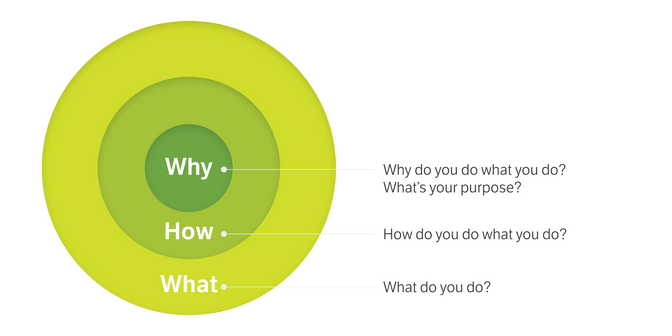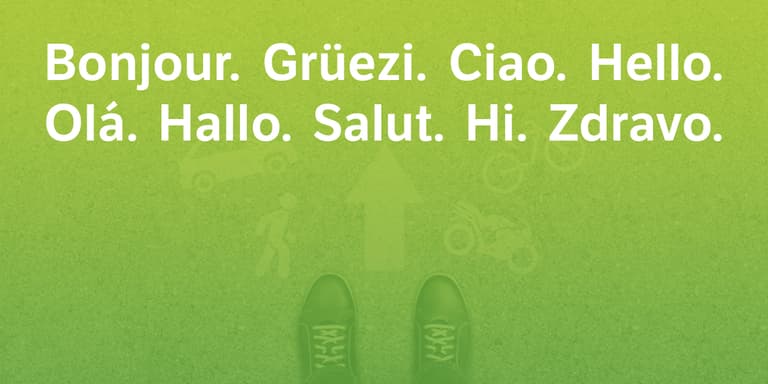For this project, which focused on updating texts, we aimed to:
- Ensure the text's quality and coherence between the different sections of the website
- Facilitate the work of the editorial team for the long term
This article explains our methods for the project. We worked in stages:
- Defining OCN’s identity
- Verbalising OCN’s identity in a form that was easy to understand and share
- Defining the bases of OCN’s voice
Defining a company’s voice helps an editorial team to understand how to convey their identity in written form.
1. Defining the company’s identity
What does that mean?
A company’s identity forms the basis of its voice. If a company’s identity is clearly defined, its voice is also easy to define.
A company’s identity is its purpose: why you do what you do. Simon Sinek’s video,Start with Why , clearly explains the importance of this question.

Your company has a purpose beyond the money you make, beyond the things you do. The better you put it into words, the better you can see it – we can only see what we have put into words. Once you have put it into words, others can see it and focus all of their efforts into making it happen. It makes work unfulfilling when we don’t know what we are working towards.
Simon Sinek, extract from the presentation Start with Why
The example of OCN
Legal foundations defining the functions and services provided by OCN. A charter defines the concept of public service.
Based on OCN’s internal charter, we formulated various questions such as:
- Why does OCN admit drivers and vehicles to road traffic?
- Why does OCN admit drivers and boats to navigation traffic?
- Why does OCN organise prevention activities and courses?
- Why does OCN enforce administrative measures (warnings and driving licence withdrawals)?
- Why does OCN collect cantonal and federal taxes (levies on vehicles and boats, charges on heavy goods vehicle traffic)?
- Are the activities grouped into categories?
During a workshop, we talked to members of the OCN project team to bring internal tacit knowledge to the fore.
In OCN’s case, we were also inspired by the websites of companies in the road safety sector.
The OCN team shared links and images of textual content that they considered to be ‘engaging’ or, alternatively, ‘overly complex’. The team explained how and why they thought this text content was ‘engaging’ or ‘overly complex’.
How can you do it?
Are your company’s activities clearly defined, yet there are no documents defining your identity or values? Ask yourself what the purpose of your company is: Why do we do what we do? Who are we? You will find some answers by reading internal documents, talking to your colleagues, and comparing your company to your competitors.
Read existing documents
You will find answers to the question Why do we exist? in documents entitled ‘corporate identity’ or ‘brand manifesto’, or in the charter of values. If such documents do not exist, talk to your colleagues.
Talk to your colleagues
Talk to your colleagues, such as the company founders and people who are in contact with your customer base. Capturing existing knowledge is vital.
You can help your colleagues to verbalise their ideas by asking questions.
For example, you could ask:
- In your view, what is our company’s most important activity?
- Why do we do this activity?
- Why is this activity important?
- If we stopped this activity, what would it change for our customers?
- Are we leaders or followers in our field?
Analyse your competitors
Analysing your competitors will allow you to identify your position in relation to them. For example, you could perform a SWOT analysis to define your strengths and weaknesses in comparison with your competitors.
During your analysis, you can also compile examples of communications that you value highly or that you wish to avoid. This will help you definining your position.
2) Verbalise your identity in the form of a vision and a mission
What does that mean?
In point 1, we compiled the key points defining your company’s identity. Now, the aim is to summarise these key points using vision and mission concepts. That is an easy way of sharing the central elements of the identity.
Your vision explains to your customers who you are, and your mission explains why you do what you do.
The example of OCN
We used Simon Sinek’s circle. During a workshop, we asked members of the team about OCN’s activities (Sinek’s How) and the aim of these activities (Sinek’s Why).
After drafting a vision and a mission, we asked for feedback from the project team to ensure that we had correctly expressed OCN’s identity.
How can you do it?
Use your research from point 1 to draft your company’s vision and mission. Be precise and concise. Avoid adjectives that are subject to interpretation such as good, nice, lovely.
Your vision conveys who you are in your sector or in relation to your customers: We are a leader in..., we are partners, we are consultants, etc.
Your mission explains what you do, above and beyond profit: We provide equality in..., we promote innovation in..., etc.
Request feedback from your colleagues
Test what you have drafted by asking your colleagues’ opinions. Ask questions like:
- Does this statement represent our company?
- If not, which word would you replace to represent our company?
- Does this statement represent why we do what we do?
- If not, which word would you replace to correctly represent why we do what we do?
If you have to explain or justify your choice of words, your draft is probably not clear. The aim is for the team to agree that ‘yes, that statement represents who we are, yes, that statement represents what we do’.
3) Define the basic principles of your voice
What does that mean?
Building on your vision and your mission, use adjectives to define how your company expresses itself. These basic principles will guide your editorial process.
The example of OCN
In OCN’s case, we selected three series of three adjectives that define OCN’s voice. Here are two examples:
Accessible
We use everyday language to be understood by all. We explain the terms and concepts that we use. We support our customers by drafting texts that enable cross-reading.
Respectful
Our language is suitable in all circumstances, no matter who we are talking to. We avoid judgemental adjectives and vocabulary loaded with alternative meanings.
How can you do it?
Choose three to seven adjectives, depending on the complexity of your voice. We recommend pairing each adjective with a brief explanation. Avoid adjectives that are subject to interpretation such as good, nice, lovely.
You could help your colleagues by suggesting adjectives, for example using post-it notes or a card game. You could ask them:
- Are we meticulous?
- Are we trendsetting?
- Are we wacky?

Request feedback from your colleagues
Test what you drafted by asking your colleagues’ opinions. Ask questions like:
- Does this adjective define how our company, or our digital product, speaks to our customers?
- If not, what is the right adjective?
Look for collaboration and suitable solutions.
Key points to remember
- Your company’s voice is based on your company’s identity
- Draw inspiration from your charter, values, and colleagues’ knowledge to define your company’s identity
- Examine how your company is positioned compared with your competitors
- Aim for collective agreement by asking for feedback from your colleagues
- Define a series of adjectives that are the principles for your voice
Share the love <3
Thank you to the OCN team, especially Fanny and the editorial team for being motivated and welcoming!
Thank you to Yves for his involvement and enthusiasm throughout the project!
Thank you to Darja, Jérémie and Tom for their valuable advice and feedback!
Thank you to Sara, a recent arrival at Liip who is already providing motivation!
Our suggested reading to learn more about this topic
Erika Heald (Content Marketing Institute): 5 Easy Steps to Define and Use Your Brand Voice
Kinneret Yifrah article posted on Medium, 6 reasons to design a voice and tone for your digital product
And of course, here is a link from my colleague Caroline on how to ensure that your voice is strong and heard.

